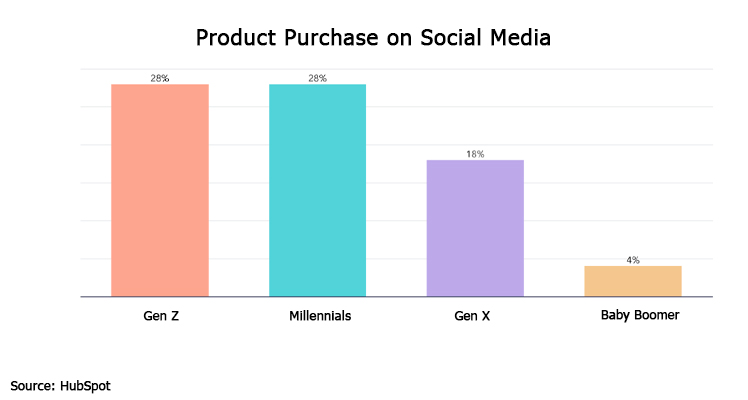
Subscribe to our Blogs
Stay on top of the latest digital marketing tips, trends & best practices.
FREE OF ANY CHARGES • NO CREDIT CARD REQUIRED
Date of Publication: 7 Mar 2023
With the advent of the digital age, understanding the different buyer generations is essential for any business to remain competitive. Buyer generations are the distinct cohorts of consumers that are born in the same period and have similar buying habits, attitudes, and behaviors. Knowing the different buyer generations, as well as their defining traits and the impact they have on business, can help organizations create marketing strategies that effectively reach and engage each segment. In this blog post, we’ll take a closer look at the different buyer generations and how they are changing the business dynamics and communication strategy

Digital Marketing Expert | Media Strategist | Entrepreneur
Born: 1928-1945 (78-95 years old)
Defining Traits:
Born: 1946-1964 (59-77 years old)
Defining Traits:
Born: 1965-1980 (43-58 years old)
Defining Traits:
Born: 1981-1996 (27-42 years old)
Defining Traits:
Born: 1997-2012 (11-26 years old)
Defining Traits:
Born: early 2010s-2025 (0-about 10 years old)
Defining Traits:
Every generation has its traits. Their needs and wants could be very different. Then, how can a product be same for all? How can a communication be same across generations?
There is no single fit all thing that exists anymore. From reading habits to daily wear demands are changing leaving discards, gaps and creating new opportunities that are yet to be addressed.
Change remains constant….only the speed has picked up like never before.
Are you still communicating the way you did 10 years back?
As per, “Forrester’s Buyers’ Journey Survey, 2022”, the younger demographics made of Millennials and Gen Zers are changing the very notions of the buyer’s journey. The survey found 64% of business purchase influencers were born after 1981, with millennials being the largest cohort here with 57%.
It becomes very important for businesses to understand where the river flows, its ebbs, and flows. The baby boomers whom the businesses addressed all these years have taken a backseat leaving these newer influencer and buyer generations calling the trends in buying behavior. It is time to think and understand the deviations that are widening with each passing year, if not months, and then plan accordingly.
Forrester’s report suggests the “younger buyers”, in over a couple of years will purchase through self-guided digital channels. Younger buyers are digital natives. In the case of B2B, when it comes to business purchases, they prefer self-service with vendors. This is a direct reflection of what they are experiencing on the customer side every day. We know that 90% of the time, business purchases are made with a group of people. That’s an important factor to consider, especially since they’re bringing their personal experiences with them to the group.
For every purchase decision they make, impulse or planned, personal or business, they tend to rely heavily on third-party information, unlike their predecessors who relied more on first party information.
And how do they seek it?
Compare this to the older buyers (born between 1946 and 1980), they obtained information from,
The new buyer generation is more serious information seekers, as their sources and options galore. Forrester’s research has found that selling to these younger buyers are more effort-consuming that the “older buyers”. The report says, younger buyers are likely to be more critical throughout their buying journeys, as 90% cited dissatisfaction with the sellers in at least one area compared to 71% that of the of older buyers.
By online presence, I don’t mean your website, your social channels, or your marketplace listing. Off course, these are must-haves. But now the game has moved on. As per research younger buying generation now base their information on third-party sources. So you need to have,
Every generation has a product preference and it changes with passing generations. The change may not be loud across the Silent Generation to Baby Boomers. But when it comes to the new buyer generations, predominantly the Millennials and Generation Z, it’s very strong. With changes in socio-economic structures, familial structures, climate changes, lifestyle, and pandemics, there has been constant change in wants and needs.
In India, air-conditioners were luxuries to Baby Boomers, wants for Gen X but a need for Millennials and Gen Zer.
Let’s take the example of mobile phones. Boomers and Gen X were happy with their pagers and old mobile phones, many still use them.
Millennials and most definitely the Zers and the Alphas probably cannot think of a like without smartphones. Yet they are not satisfied with the one they have. They want to have the latest mobile with newer processing capacity and functionalities.
Mobiles have now gone beyond the basic functions that are to call and texting. Social media simultaneously gaining adhesion, camera quality, and editing features now have become the differentiating factors for mobile handsets. Hence, products like Samsung Galaxy S23, Oneplus 11, and iPhone 14 Pro Max, which may be the latest in line today, are likely to get dated in a year’s time.
Yet there are businesses that want to sit tight because past ways have made them what they are today. For them change is too frequent and confusing. So why change?
Have you heard of Kodak, Yahoo, Xerox, Nokia, and JC Penny? Do you see them now? Weren’t those companies too big to fail?
They failed because they did not change.
What worked yesterday will not work today and definitely not tomorrow….No Ways!!
These younger generations are now the principal decision-makers when it comes to purchasing.
But you still have the older generations. They may have shrunk but are still somewhat relevant.
Thus, making products for every segment in every buyer generation allows companies to reach a wider range of potential customers and increase their overall sales.
It helps to create a larger customer base, build brand loyalty, and increase profits. By having a variety of products, companies can also better understand customer needs and preferences, allowing them to tailor their offerings to meet the changing needs of their customers. Furthermore, it enables companies to remain competitive in their respective markets and provide customer-centric solutions.
Warning:
Forget Millennials and Gen Z, the Gen Alphas are coming. They have spent almost two and half years of their formative time locked in their homes with screens and family as their only company. This complex generation has now just entered their teens. A few years from now they will rule the buyers’ behavior with Gen Z, displacing the Millennials.
Have you thought it out? Have you planned for them yet?
Every generation has a story to tell.
They even have their own music.
There was a survey by Robert’s Radio to find how familiar 2000 respondents with various artists were in the UK. The result showed just 18% of the Silent Generation related themselves to the music of the Millennials, Gen Z, and Gen Alpha. 34% of Gen Z found older songs boring. However, when checked with Silent Generation they found boredom from songs before of their time at just 1.85%.
Over 75% of Gen Z does not like to listen to a song released before they were born.
The new generations cannot relate to Beetles, Elvis, Bon Jovi, and Pink Floyd.
51.72% of Gen Z don’t know much about Pink Floyd.
Isn’t it mind-opening?
Not just the story or music even the choice of communication channels varies with generations. A HubSpot study shows each generation discovers products differently. Social media, internet search, and YouTube ads are key for reaching Gen Z and Millennials, while TV, search, and retail are favored by Gen X and Boomers.

When it comes to the choice of social media Boomers, Gen Z, and Millennials all use Facebook more than any other app. While Gen Z is all about YouTube, Instagram, and TikTok. Not just engaging with friends and getting entertained, the propensity of product discovery is much higher on social media for Gen Z than any other buyer generation.
Now we know, 57% of Gen Z discover new products on social media. And by social media, it is YouTube, Instagram, and TikTok that rules the roost. It is not surprising because on average they spent 4hour 20 min on social media each day.

Though purchase through digital channels are picking up In store purchases, though have degrown, are still holds the top position. 55% of Gen Z and 65% of Millennials still buy from physical stores.
Buying through Online Marketplaces like Amazon eBay, Flipkart, etc has increased since the pandemic years. The younger buyer generations are more interested in buying through social media and from a company’s website (if it proves reliable and trustworthy).

What remains common across age groups is that they are highly influenced by price, quality, and product reviews.
Millennial and Gen Z prefer brands that have active brand communities.
Today, another social factor that crept into the purchase decision of Gen Z is whether a percentage of their money spent on purchases is going to charity.
The impact of different buyer generations on business can be significant. Understanding the traits and preferences of each generation is essential to creating an effective marketing and sales strategy. Businesses can use this knowledge to craft messaging and experiences that appeal to the different generations, resulting in increased customer loyalty, higher profits, and a better overall customer experience. By recognizing the value of different generations, businesses can create a more successful, sustainable, and profitable operation.
If you have found this blog helpful please like & share
We hope the article helped you understand the topic, but you might still have questions about how it can work for your business / brand. At Tejom Digital, we have built a reputation for answering those tricky questions.
Are you looking to take your business to the next level?
Tejom Digital
is here to help!
Our award-winning digital marketing agency has the expertise and data-driven solutions to ensure optimal reach, engagement, traffic and conversion. With our proven strategies, you can rest assured that your business will be seen by the right people and achieve your desired outcomes. Plus, we offer comprehensive and personalized packages tailored to your specific needs! Let us help you reach your goals today.
FREE OF ANY CHARGES • NO CREDIT CARD REQUIRED







Anirban Guha is an MBA graduate from Amity University, Noida. Starting his career with The Times of India Group, he has spent over 16 years in advertising and has been the founder-director of an award-winning digital marketing agency, Tejom Digital for over 6 years. He has worked with some of the top brands in India and beyond. He is an expert in creative design and digital marketing. He is passionate about helping businesses reach their goals. Beside his professional life, Anirban is an avid reader, a movie buff, a passionate gardener, an art enthusiast, and a foodie.